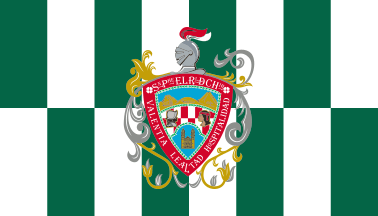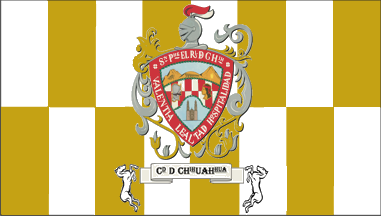
by Juan Manuel Gabino Villascán, 17 March 2015.
1 | 2 | 3 | 4 | 5
Flag adopted: 12 October 2006

Last modified: 2022-09-23 by juan manuel gabino villascán
Keywords: mexico | chihuahua | chihuahua (city) | coat of arms | cathedral | indian | native | head | spaniard | tarahumara |
Links: FOTW homepage |
search |
disclaimer and copyright |
write us |
mirrors

by Juan Manuel Gabino Villascán, 17 March 2015.
1 |
2 |
3 |
4 |
5
Flag adopted: 12 October 2006
The municipality of Chihuahua (Mexico) plans to adopt a flag and an anthem. A contest shaould be launched by the Commission of Culture and the Culture Institute of the municipality. The report (dated 20 October 2005) of the last session of the municipal council includes the following paragraph: "En asuntos generales, la regidora María Teresa Dickens presentó una propuesta para que la Comisión de Cultura, en conjunto con el Instituto de Cultura del Municipio, desarrollen las bases de la convocatoria para celebrar un concurso encaminado a la creación de un himno y una bandera para Chihuahua."
From
Más noticias. La Red del Norte.
Reported by Ivan Sache, Octuber 2005.
According to Pedro Fierro, "Tiempo La Noticia Digital", 6 October 2006, Orlando Barraza Chávez, "regidor de Cultura" for the municipality of Chihuahua, announced that the jury, including, among others, Jesús Ávalos Portilla, the Director of the Municipal Culture Institute, elected the design proposed by Bonifacio Martínez. The winner will be awarded his prize in a ceremony to be held in the City Hall of Chihuahua on 12 October.
From
El Tiempo.
Reported by Ivan Sache, Octuber 2006.
En sesión extraordinaria del cabildo, el regidor Orlando Barraza, presidente de la comisión de cultura, dio a conocer al ganador del concurso para la creación de la bandera de la ciudad de Chihuahua: "Cachorro", seudónimo utilizado por Bonifacio Martínez García, fue designado como ganador debido a que cumplió con cada uno de los requisitos establecidos en la convocatoria, en la cual se presentaron 5 concursantes más bajo los seudónimos, "sueño guajiro", "caballero medieval", "flor de cerezo", "esperanza" y "carrera". Además de la creación de la bandera de la ciudad, se colocará una placa conmemorativa en el Instituto de Cultura del Municipio donde quedará asentado como creador de este símbolo de pertenencia, el señor Bonifacio Martínez García.
From
Ayuntamiento de Chihuahua, Administración 2004-2007.
Reported by Juan Manuel Gabino Villascán, Octuber 2006.
 4:7
4:7
by Juan Manuel Gabino Villascán, March 17, 2005.
Based on Official web-site of the Ayuntamiento de Chihuahua
Description of the arms is provided in Spanish only from: Official web-site of the Ayuntamiento de Chihuahua
Las comunidades van quedando unidas por un universo simbólico; por un territorio y ámbito geográfico definido; por una historia compartida de lucha, sufrimiento y gloria; por una forma de ser que les da carácter e identidad propios y les hace diferentes de las demás sociedades; pero sobre todo, su gente se une por una misma meta: un futuro de prosperidad y bienestar. Debido a ello, adoptan un emblema de sus anhelos y objetivos comunes: la bandera. La Bandera del Municipio de Chihuahua está formada por 2 franjas que alternan 8 cuadros blancos y 8 verdes del mismo tamaño que representan los votos a favor y en contra que se emitieron para definir la fundación de la ciudad en 1709. Sus colores poseen un significado particular. El blanco es símbolo del equilibrio, la sabiduría, la unión y la paz que deben prevalecer entre los chihuahuenses. El verde representa la vida, la juventud, la alegría y la esperanza de un pueblo, es un color que anima y estimula a esforzarse por una vida mejor. Al centro del lábaro se encuentra el Escudo de Armas del Municipio de Chihuahua, figura que encarna el orgullo que sienten sus habitantes por la riqueza de su pasado histórico y nos describe las características que los distinguen: la valentía, la lealtad y la hospitalidad.
From
Ayuntamiento de Chihuahua, Administración 2001-2004, 2004.
Reported by Carlos Campos Rivas, September 5, 2004.

from
Wikipedia
This image from Wikipeda features a ribbon with the city name held by two Xoloitzcuintli (Mexican hairless dogs). The first mistake is the ribbon that should be curved; secondly, the Xoloitzcuitli-like figures should be actually two Chihuahua dogs. Unfortunately the has been used for official porposes:
1 and
2
Juan Manuel Gabino Villascán, 13 December 2019
.gif)
by Juan Manuel Gabino Villascán, 17 March 2005.
Arms adopted: 30 September 1941.
This is a Gothic shield with a red border charged with the abbreviate City's colonial name in
Old Spanish, and the motto: Courage, Loyalty, and Hospitality. It was proposed by Francisco
R. Almada, León Barri Paredes and José Carlos Ch´vez, and aproved officialy on September 30, 1941.
Within the shield there are three parts: the first one in the chief,
bears a mine winch, an old aqueduct, and a mezquite tree; the second in the center, is checkered in white and
red, and has the heads of a Spanish soldier and a Tarahumara woman's, both looking towards the center; in
the bottom, the facade (front) of the Cathedral of Chihuahua. The quarters are separated by
laurel branches. In the top, a silver helm and mantling.
Juan Manuel Gabino Villascán, September 9, 2004.
On 30 September 1941, the Chihuahua City Council agreed to accept the shield that was proposed for the municipality by Francisco R. Almada, León Barrí Paredes and José Carlos Chávez:
Gothic shield. The point is a half-ogive, exceeded and vaulted cut at the top. It is surrounded by boder of gules (red) and the name San Felipe el Real de Chihuahua abbreviated, with ancient Spanish lettering, in the vaulted part, and in each upper vertex, an apple blossom. Continuing on the same border, the word Valentí (Courage) on the right side; using the lower tip Lealtad (Loyalty); and on the left side, Hospitalidad (Hospitality), written in silver letters and opposed to the central convergence. The main part is divided into three unequal sections, delimited by a line of sinople (green) bay leaves. In the section of the chief, in gold, first, three figures: On the right, a winch of mines, in the center, a truncated aqueduct; and to the sinister, a mesquite tree. In the background, on the field of azure (blue), the hills of El Coronel, Santa Rosa and El Grande, these are pale pink. In the middle section, on the field of sixteen alternating and irregular checksheets in silver and gules (red), on the right, the head of a Spanish soldier, in profile, with a closed beard, touched with a morrion and a cap; at the sinister and at the same height as the previous one, the profile of the head of a Tarahumara woman, touched with a turban in gules (red koyera) that girdles her forehead and holds her hair, which falls down to the height of shoulders; both overlooking the center and on a gold medallion superimposed on the checks. In the point, the facade of the Cathedral of Chihuahua, in gold, on azure (blue). The shield bears a closed helmet, viewing to the right, and a plume on the top of red and white feathers. It is surrounded and covered by gold and silver mantling.
The helmet carries a plume composed of a red and a white feathers, colors of the ensign of the knights of the Order of Santiago, in memory of the founder of the City, who belonged to this Order. The gold and silver lambrequins (mantling) points out the abundance and importance of these metals in mining, as well as the work that surrounds it as support: agriculture, livestock, industry and commerce, both in the municipality and in the state. At the top, in the vaulted edge, Sn. Phe. the Rl. of Chih. It is flanked by an apple blossom in each of the upper vertices, and this flower represents Chihuahua and Chihuahuan people in the cultural centers. The words Courage, Loyalty and Hospitality, which surround and frame the shield, are a representation of the qualities and features of Chihuahuan people. The bay line symbolizes the triumphs that the Chihuahua have achieved in all fields of human activity.
In the Chief Section, the winch of mines is for the work and recalls what was the main wealth of the state and its children, and that gave birth to many towns, some of which are among the most [important in the state]. The aqueduct, the first monumental work of our colonial ancestors of this population, indicates the ancestral lack and the desire to obtain the satisfiers in the desert. The mesquite tree, a xerophilous plant, characterizes and represents all the flora. The hills, which are part of our landscape, also symbolize the inhospitability of these lands.
In the middle section, the checks, in silver and red, are the votes that were issued for and against to decide the foundation of this population in 1709, as opposed to the other place that was Santa Eulalia de Merida de Chihuahua, and that, when establishing itself in the intersection of the Sacramento and Chuviscar rivers, it was by the definive vote issued by Don Antonio de Deza y Ulloa y Mencia, Governor of the Province of Nueva Vizcaya. It was on 12 October 1709 when the population was founded with the name of San Francisco de Cuellar. On 1 October 1718, the settlement reached the rank of Villa (Town) de San Felipe el Real de Chihuahua, and changed on 19 July 1823 to that of Ciudad de Chihuahua, as capital of the state, which is named after the city. It is remarkable in this section, on a stylized gold medallion, on the right, a Spanish soldier; and to the sinister, a Tarahumara woman, both with a view of the center [of the field], which represents the importance of colonization, as well as meztizaje. In the lower section, on the blue field, the facade of our Cathedral, a beautiful colonial monument, so revered by the Chihuahuan people, expresses their solid faith.
From
Ayuntamiento de Chihuahua, Administración 2001-2004, 2004.
Reported by Carlos Campos Rivas, September 5, 2004.
Translated by Juan Manuel Gabino Villascán
Anything below this line was not added by the editor of this page.